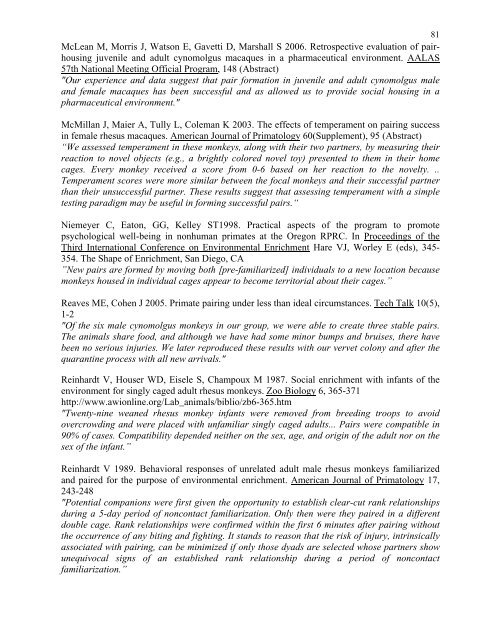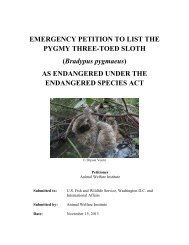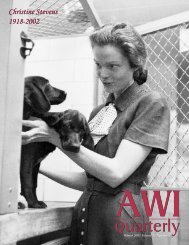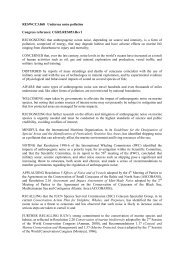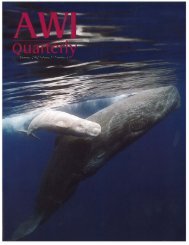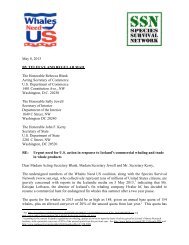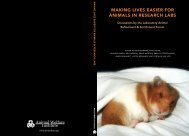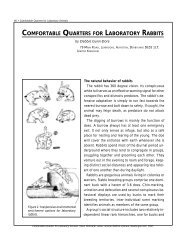Re finem for Annot ment a Prima tated nd En ates K Biblio vironm ...
Re finem for Annot ment a Prima tated nd En ates K Biblio vironm ...
Re finem for Annot ment a Prima tated nd En ates K Biblio vironm ...
Create successful ePaper yourself
Turn your PDF publications into a flip-book with our unique Google optimized e-Paper software.
81McLean M, Morris J, Watson E, Gavetti D, Marshall S 2006. <strong>Re</strong>trospective evaluation of pairhousingjuvenile a<strong>nd</strong> adult cynomolgus macaques in a pharmaceutical environ<strong>ment</strong>. AALAS57th National Meeting Official Program, 148 (Abstract)"Our experience a<strong>nd</strong> data suggest that pair <strong>for</strong>mation in juvenile a<strong>nd</strong> adult cynomolgus malea<strong>nd</strong> female macaques has been successful a<strong>nd</strong> as allowed us to provide social housing in apharmaceutical environ<strong>ment</strong>."McMillan J, Maier A, Tully L, Coleman K 2003. The effects of tempera<strong>ment</strong> on pairing successin female rhesus macaques. American Journal of <strong>Prima</strong>tology 60(Supple<strong>ment</strong>), 95 (Abstract)“We assessed tempera<strong>ment</strong> in these monkeys, along with their two partners, by measuring theirreaction to novel objects (e.g., a brightly colored novel toy) presented to them in their homecages. Every monkey received a score from 0-6 based on her reaction to the novelty. ..Tempera<strong>ment</strong> scores were more similar between the focal monkeys a<strong>nd</strong> their successful partnerthan their unsuccessful partner. These results suggest that assessing tempera<strong>ment</strong> with a simpletesting paradigm may be useful in <strong>for</strong>ming successful pairs.“Niemeyer C, Eaton, GG, Kelley ST1998. Practical aspects of the program to promotepsychological well-being in nonhuman prim<strong>ates</strong> at the Oregon RPRC. In Proceedings of theThird International Conference on <strong>En</strong>viron<strong>ment</strong>al <strong>En</strong>rich<strong>ment</strong> Hare VJ, Worley E (eds), 345-354. The Shape of <strong>En</strong>rich<strong>ment</strong>, San Diego, CA”New pairs are <strong>for</strong>med by moving both [pre-familiarized] i<strong>nd</strong>ividuals to a new location becausemonkeys housed in i<strong>nd</strong>ividual cages appear to become territorial about their cages.”<strong>Re</strong>aves ME, Cohen J 2005. <strong>Prima</strong>te pairing u<strong>nd</strong>er less than ideal circumstances. Tech Talk 10(5),1-2"Of the six male cynomolgus monkeys in our group, we were able to create three stable pairs.The animals share food, a<strong>nd</strong> although we have had some minor bumps a<strong>nd</strong> bruises, there havebeen no serious injuries. We later reproduced these results with our vervet colony a<strong>nd</strong> after thequarantine process with all new arrivals."<strong>Re</strong>inhardt V, Houser WD, Eisele S, Champoux M 1987. Social enrich<strong>ment</strong> with infants of theenviron<strong>ment</strong> <strong>for</strong> singly caged adult rhesus monkeys. Zoo Biology 6, 365-371http://www.awionline.org/Lab_animals/biblio/zb6-365.htm"Twenty-nine weaned rhesus monkey infants were removed from breeding troops to avoidovercrowding a<strong>nd</strong> were placed with unfamiliar singly caged adults... Pairs were compatible in90% of cases. Compatibility depe<strong>nd</strong>ed neither on the sex, age, a<strong>nd</strong> origin of the adult nor on thesex of the infant.”<strong>Re</strong>inhardt V 1989. Behavioral responses of unrelated adult male rhesus monkeys familiarizeda<strong>nd</strong> paired <strong>for</strong> the purpose of environ<strong>ment</strong>al enrich<strong>ment</strong>. American Journal of <strong>Prima</strong>tology 17,243-248"Potential companions were first given the opportunity to establish clear-cut rank relationshipsduring a 5-day period of noncontact familiarization. Only then were they paired in a differentdouble cage. Rank relationships were confirmed within the first 6 minutes after pairing withoutthe occurrence of any biting a<strong>nd</strong> fighting. It sta<strong>nd</strong>s to reason that the risk of injury, intrinsicallyassociated with pairing, can be minimized if only those dyads are selected whose partners showunequivocal signs of an established rank relationship during a period of noncontactfamiliarization.”


